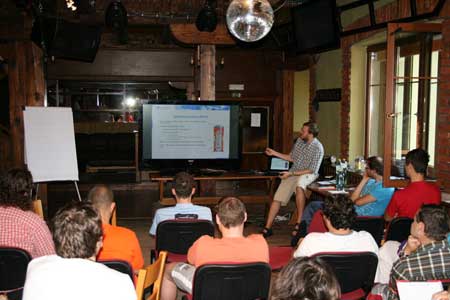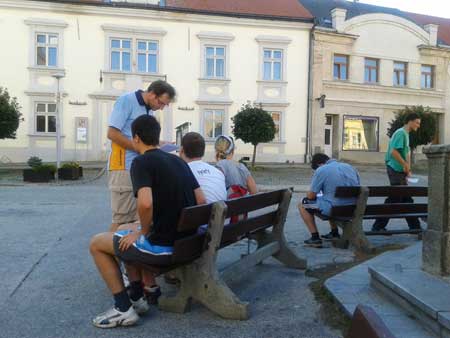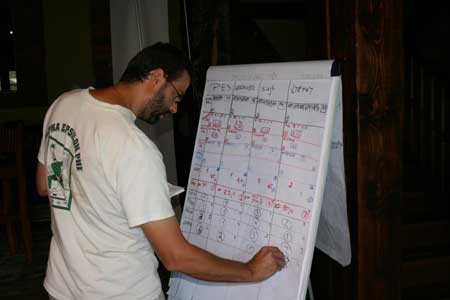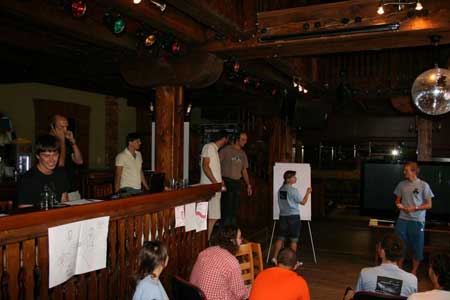
CENEN Summer School of Nuclear Engineering
By K. Katovský, M. Malá, J. Prehradný, O. Zlámal
Summer time is certainly not vacation time for a group of nuclear scholars and engineers involved in the CENEN (Czech Nuclear Education Network). They are busy organising the annual Summer School of Nuclear Engineering (SSoNE) in Počátky, a small lively town on the Bohemia-Moravia border, in the Czech Republic. And summer 2012 was no exception. For the fifth time students from various Czech nuclear-related universities were offered a chance to follow a one-week nuclear course, taking part in debates with nuclear professionals and visiting nuclear facilities - and all in a relaxed atmosphere and transparent environment.

Ondřej Zlámal is presenting about relation between applied nuclear research and commercial development of nuclear energy.
Every summer school is organised under one main headline topic – and this time the topic was Before we start building … The topic alludes to the much-discussed - and so far unconfirmed - expansion of Temelín NPP by the addition of two more units. Temelín NPP plays a central part in the CENEN’s SSoNE as it is just one hour away by bus and provides an ideal location for a technical visit. Such visits are mutually enriching experiences, both for students who, often for a first time, can have a finger on the pulse of an operating nuclear power plant, and for Temelín staff who get to meet bright and willing-to-learn students who might one day become their future colleagues.
Even though the Czech Republic is a largely pro-nuclear country, it is rather small and so the possibility of getting a nuclear education in the Czech Republic is limited to attending one of a few technical universities. The latter are not always strictly focused on nuclear engineering. This results in a rather broad spectrum of SSoNE participants; all are somehow “nuclear”, but each has a different background that must be taken into account. This year four technical universities were represented by twenty-one students from eight departments. The great majority of students were studying power engineering; the rest included a mixture of mechanical, material and nuclear engineering students. Participants were divided into four teams that competed in a week-long game centred on the expansion of Temelín NPP, called "Temelín, build up!" The game was quite similar to Ludo: all teams started with a greenfield site, were given an opportunity to build and had to overcome a variety of challenges, such as a feasibility study, an environmental impact assessment (EIA), a specific unit design and selection of vendors to choose from, etc.

One of outdoor activities: cipher game around Počátky town
On the first day of the course, which was organised under the heading of How about piece of cake? - and before they were even introduced to each other or the rules of the summer school - students visited the only operating uranium mine in use in central Europe. This is the Rožná I mine. Nineteen students went down the mine shaft to a depth of approx. 1050 m underground. The Rožná I mine belongs to GEAM Diamo, a state-owned company, which is currently mining uranium there and uses a nearby chemical plant to produce the yellow cake. After the visit to the mine, students were divided into four teams and assigned the task of creating a really original name for their team. Their young minds and active imaginations came up with following names: PES (Czech for “Počátky Energy Company”, but also Czech for dog), 2) JADERNOBYL (a play on words with CHERNOBYL and Czech for “Nuclear”, 3) S.U.J.B. (witty choice – SUJB is Czech nuclear regulatory authority but also an abbreviation for Czech “Socially Tired Nuclear Rednecks” according to students) and 4) ŠTEPKY (Czech short for fission products). Intentionally, it was proposed that all the teams be headed by girls – who all gratefully accepted the challenge.
On Saturday, the students explored the theme What is ahead for Czech nuclear? The head of Czech nuclear regular authority, Dr. Dana Drábová, began by giving an overview of the Czech Republic’s energy mixture, emphasising nuclear and its future prospects. She proved herself to be a truly great expert on the power sector, pointing out the advantages and disadvantages of each energy source available in the Czech Republic. Her lecture was followed by open discussion with students, during which recent news on the Doel 3 NPP, in Belgium, was mentioned. Questions were also raised on the Fukushima accident. After lunch there was a short quiz on nuclear terminology, which was presented by the SSoNE organisers. Students then followed an introductory “Compressed Nuclear Lecture”, which was a basic refresher course on nuclear physics given by Dr. Karel Katovský, one of the SSoNE organisers. This lecture was followed by two more Compressed Nuclear Lectures. The second one focused on a summary of nuclear technology worldwide and was presented by Dr. Pavel Zácha. The third one provided an overview of thermo-hydraulics and was delivered by Dr. Václav Dostál. Those who paid attention were rewarded later that evening, when a short test covering all three lectures offered each team a chance to win some extra points.

Václav Dostál is carefully distributing points in week-long game "Temelín, build up!"
Sunday’s theme was When too many neutrons are bad for your health. It consisted of another Compressed Nuclear Lecture on nuclear safety. This one emphasised the physical barriers that protect against the leakage against fission products and PSA. Shortly after lunch another quiz tested how much the students had paid attention to the morning lecture and more points were distributed among the teams. That afternoon Dr. Radek Škoda’s gave a lecture on nuclear economics, during which fascinating data on long-term economics were demonstrated with crystal clarity. Dr. Škoda then gave an eye-catching presentation that compared Gen II, Gen III and Gen IV reactors and provided illustrations of recently designed reactor systems. Sunday’s programme concluded with a game of “Nuclear darts”, which closely resembles normal darts but uses a fuel assembly diagram with various fuel elements enrichment as the dart board.
Monday was set aside by the organisers for a visit to the Temelín NPP’s simulator. Consequently, the day was renamed Homer Simpson Monday. Students were shown reactor emergency shutdown training exercises that showed what would happen were a main circulation pump failure to occur or a leakage from the primary to the secondary circuit. After lunch Pavel Šimák presented the latest developments with regards to new build in the Czech Republic and the neighboring countries. The day finished with another game, called “Nuclear Jeopardy,” where students competed to provide the fastest correct answer to nuclear-related questions and gained points for their respective teams.
Red and expensive, or green and cheap? was the theme for Tuesday. The day started with a lecture from Iva Kubáňová, from ČEZ’s New Build Department. She highlighted the Environment Impact Assessment (EIA) procedure for the proposed Temelín 3 and 4 units. Mrs. Kubáňová highlighted many interesting issues raised by the proposed Temelín 3 and 4 new build project, such as 60 years of operation time, a load factor of above 90% and fulfilling European Utility Requirements (EUR). The lecture was followed by another Compressed Nuclear Lecture, this time given by Karel Katovský. The subject was the fuel cycle. Tuesday afternoon was devoted to outdoor activity: teams were equipped with a GPS equipped with a cipher quiz on Počátky. After returning to “home base” teams spent the evening playing the quiz game Who wants to be nuclear millionaire? It gave them a chance to show off how they had rapidly increased their knowledge of nuclear.
On Wednesday, the working theme was Do you speak atom? It was all about nuclear communications. The day began with a lecture from Marie Dufková, one of ČEZ’s senior communicators. She shared with students her experiences with communicating with the media and the general public. After lunch another outdoor activity was prepared: Building your own NPP! Teams were assigned the task of being one of the interested parties in the construction and operation of an NPP (a utility, the nuclear regulator, a NPP vendor and the government). The communication was limited to writing short notes for other teams – without knowing the objective of the game (which was building an NPP). The activity was followed by another presentation on nuclear communications, given by Jiří Marek. He actually gave two lectures relating to radioactive waste, the first one on the NIMBY (Not In My Back Yard) phenomenon and the other one on the Oklo natural reactor. As the sun was setting, young representatives of five potential nuclear employers engaged in a debate with students, followed by a fun Q&A session from the SSoNE organisers. Among the questions asked were How many steps and floors must you go up every day? or Does your director know you by name? The objective of the Q&A session was to give the human face of often tough PR presentations.
Thursday focused on the theme From quarks to the electric plug and began with a presentation from Ondřej Zlámal. He spoke about the relation between nuclear research and the commercial utilisation of nuclear power. Václav Dostál used rest time after the lunch to give a presentation on nuclear weapons: their history, basic design approaches and what threat they pose. That afternoon Miroslav Kawalec gave a lecture on the Czech industry’s preparedness for nuclear new-build. Students then took part in another points-gaining activity: the identification of common movie mistakes about nuclear. To give the students some time off, the evening was reserved for “inverse activity”: instead of the students it was the organizers themselves who had to play the role of students and were given various tasks to perform, such as to come up with a rap song on the subject of nuclear, compose nuclear poetry and nuclear country songs, take part in quizzes and in a blind taste “coolants” competition (the teachers had to guess which “coolant” they had tasted).

Inverse activity: Organizers are given instruction how to prove themselvesc
The final day of the SSoNE addressed the topic Is one catfish better than five trouts? The day was devoted to small modular reactors (SMR). Jan Zdebor, from Škoda JS, delivered a lecture on the perspectives, advantages and disadvantages of SMRs and analyzed all recently-developed SMRs in detail. After his speech, the organisers announced the winners of the Temelín, build up! game and the summer school was brought to a close. Students then returned home to their universities.
We all hope that CENEN’s Summer School of Nuclear Engineering left a deep impression on the students and set them nicely on course for a future in nuclear.
|

